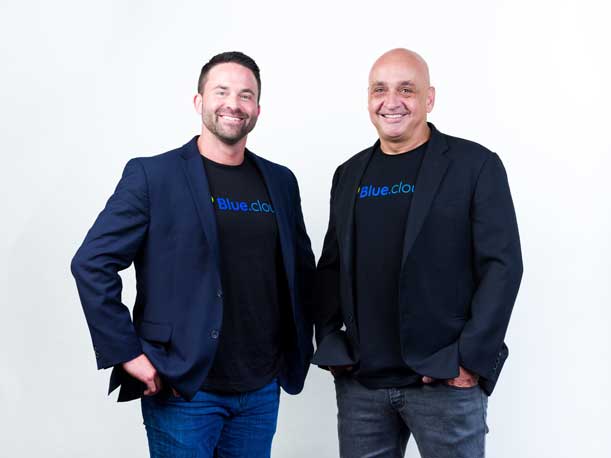BlueCloud CEO: We’re Investing In AI, More Partnerships
‘This is a huge hype cycle,’ says Kerem Koca, BlueCloud founder and CEO, about AI. ‘People are saying that this is big or bigger than the internet revolution or mobile. It could be bigger than both. I think it’s powered by both of those functions, but it’s significantly going to change how they operate in the next decade or two.’

BlueCloud’s Bill Tennant and Kerem Koca
BlueCloud’s Kerem Koca believes ChatGPT and AI will be as big as the internet, possibly even bigger.
“This is a huge hype cycle,” Koca, BlueCloud founder and CEO, told CRN. “People are saying that this is big or bigger than the internet revolution or mobile. It could be bigger than both. I think it’s powered by both of those functions, but it’s significantly going to change how they operate in the next decade or two.”
As a Snowflake Elite partner, BlueCloud delivers next-generation technologies to help customers make innovative business decisions and cites Snowflake’s Data Cloud as an integral platform to help customers achieve true digital transformation.
The Tampa, Fla.-based solution provider, No. 4 on CRN’s 2022 Fast Growth 150, also launched a new retail vertical and hired two industry experts, Iaro Boutorine and Denis Drost as vice presidents, co-heads of retail practice, to establish best practices for retail and consumer-packaged goods.
The two experts will work closely with BlueCloud’s data, analytics and AI teams to expand solution offerings and drive value within the customer base.
“With the success that ChatGPT created, everyone is now asking, ‘Can we implement this? Are we behind? What kind of productivity gains are going to be created for this?’” Koca told CRN. “We knew that AI is only going to work when you go to the cloud and have the data on the cloud, as well as the supercomputing capabilities of the cloud, enabling these models to be applicable.”
Modern data management unlocks critical information to provide a seamless experience for consumers with advanced capabilities such as merging external data with internal data and improving supply chain operations and demand. BlueCloud specializes in implementing modern data and analytics solutions to help customers leverage next-generation technologies to accelerate their digital transformation efforts.
“We’ve been growing pretty dramatically through our partnerships and a lot of word of mouth, and we wanted to take that to the next level,” Bill Tennant, CRO of BlueCloud, told CRN. “So my task was add to the sales team, expand the partnerships and add new customers while also expanding existing customers.”
CRN spoke with Koca and Tennant and the company’s newest ventures, AI and what’s to come for BlueCloud.

BlueCloud recently launched into a retail vertical. Tell me more about that.
Tennant: We’re expanding into the retail and CPG [consumer-packaged goods] space and leveraging the technology partners that we have with Thoughtspot and Snowflake. We’ve also recently expanded into some other partnerships that are complementary to that partner matrix. It opened the door for us to be able to differentiate in the retail and CPG space.
If you think about some of the use cases that are there, such as sharing data between the retailer and the supplier, vendor compliance, out of stocks, inventory and supply chain, that is an area where we believe that our focus would allow us to dramatically expand our reach and capability as a whole. Couple that with the fact that we have connections into the retail and CPG space through members of our board. So launching that vertical, from a go-to-market standpoint, made a lot of sense for us. Our focus there is really trying to uncover and take advantage of some of the use cases.
Kerem, when we spoke last year you said the company had 185 percent year-over-year growth. What kind of growth have you seen this year?
Koca: This year we invested more on growth in partnerships. Instead of continuing investing in just expanding our revenue, what we are doing more this year is expanding the number of Fortune 500 customers we have and creating significant customer projects with them. I think that’s going to give us, for the next year or two, a much more diverse customer base with strong partnerships and growth in a healthy way.

When we talked about growth last year, you said it was directly related to the increasing demand for cloud data and analytics solutions. Are those still the key aspects of increased growth?
Koca: Our delivery positioning helps a lot because cost optimization is important now. Even for cloud usage, cost optimization is becoming important. Our customers are now, for the first time ever, looking at their cloud spend and saying, ‘Is it the best way of using? Can it be optimized?’ On the implementation side, the same is coming.
So where do you think your customers will have the most IT spend this year?
Koca: I think the only difference this year will be AI as it’s becoming a much more serious topic. Other than that, I think the overall direction is not going to change that much, but there is more care and scrutiny as CFOs are more involved with decisions. [They are starting to ask], ‘Do we need this project or not?’ Before, any cloud project was a good project but now they’re looking at it as, ‘Do we really need this and what is the best way of developing this?’
With the success that ChatGPT created, everyone is now asking, ‘Can we implement this? Are we behind? What kind of productivity gains are going to be created for this?’ We know that AI is only going to work when you go to the cloud and have the data on the cloud, as well as the supercomputing capabilities of the cloud, enabling these models to be applicable. Nothing that open AI implemented is new. What wasn’t there is all of the data to be available free on the cloud and the capabilities of the cloud to run those models and get those results. I think finally we came to this point that everything came together.
[Another question customers are asking is], “’How is AI going to affect my business? What should I do? How can I make changes so that we’re not behind?’ It’s a rapid implementation. Having fundamental cloud strategy and data strategy are important because if you don’t have those, it will not work. But finding good use cases and understanding the improvements that this is going to make for us is important for our customers, [as well as] rapidly implementing them to the processes because if they don’t someone else is going to.
This is a huge hype cycle. People are saying that this is big or bigger than the internet revolution or mobile. It could be bigger than both. I think it’s powered by both of those functions, but it’s significantly going to change how they operate in the next decade or two.

Aside from partnerships, what else are you investing in this year?
Koca: We created a very complex, very sophisticated engagement office that improves our delivery capabilities as well as provides the best talent to our customers. That has been an important investment that changed how we operate internally. The outcomes are going to be felt in all these areas. I think our projects are going to be more successful, our customers are going to be happier and our employees are going to be happier because we’re putting serious thought in how we allocate our resources in the best way to add value to customers. I think we created a great team in the last three to six months to enable that. We’re continuously investing in our Snowflake partnership to make sure we have a single mandate. We want to be their most effective partner, anytime they need to win a project we want them to come to us.
What can we expect to see from BlueCloud for the rest of the year?
Tennant: What we’re trying to do is create the perfect blend of product and service organization. It’s a very different type of company where we’re out there innovating on top of the product partnerships that we have. The team has started to call it the BlueCloud Innovation Lab. It’s creating additional solutions and accelerators that help us to drive value faster, which is kind of the reverse of what a lot of service delivery companies tried to do, which is to plan out that longtail project. We’re trying to deliver value as fast as possible to customers and continuously maintain that high quality. It kind of bridges that gap between technology and delivery and value and pulls it all together.